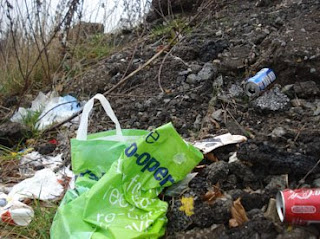In a recent blog I mentioned the geology of the chalk landscape around here and at Oughton Head there is a superb example of where the water from the chalk hills around Offley and Lilley emerges from underground. There is quite a steep sided tree-lined gully at the spring head, then there is then quite a wide and shallow river that extends through the trees to the main part of the nature reserve. On the morning of my visit I had cycled there over some bridleways that I hadn't been on before and so this was quite a day for new discoveries. The sky was clear with bright sunshine but a chilly breeze blew in exposed places. Celandines, violets, daffodils and trees full of blossom were appearing everywhere. Spring had definitely sprung.
At Oughton Head I find a place to sit beside the waters edge and begin to write:
 At the spring head, a few hundred yards upstream from where I sit, the sparkling clear waters emerge into the bright and welcoming sunshine that is awakening the winter landscape. My first impressions were of a place of beauty but also of a place well used by the public. There were well worn paths down to the waters edge, several paths though the trees and a reasonable amount of rubbish (car tyres, bottles and bits of metal) and branches had been thrown into the water. It is amazing how water always attracts people. A place like this is a huge natural playground, presumably enjoyed by many young people. On this Sunday morning there were many people out and about: just sitting, walking their dogs, riding horses, out on their bikes with families or just enjoying a gentle stroll.
At the spring head, a few hundred yards upstream from where I sit, the sparkling clear waters emerge into the bright and welcoming sunshine that is awakening the winter landscape. My first impressions were of a place of beauty but also of a place well used by the public. There were well worn paths down to the waters edge, several paths though the trees and a reasonable amount of rubbish (car tyres, bottles and bits of metal) and branches had been thrown into the water. It is amazing how water always attracts people. A place like this is a huge natural playground, presumably enjoyed by many young people. On this Sunday morning there were many people out and about: just sitting, walking their dogs, riding horses, out on their bikes with families or just enjoying a gentle stroll.It is into this landscape that the clear, fresh spring water, permeating through the white chalk for goodness knows how long, emerges. It is welcomed by the sunlight, by trees, by birdsong, by people and by our rubbish. I am aware, however, that the water may not be as pure as one might imagine. Has the chalk filtered out all the chemicals from fertilizers or from road-side ditches I wonder? Water is all too often not viewed with the reverence that it deserves. It is a sacred and integral part not just of the landscape, but also ourselves and the whole of life depends on it. It may well be a convenient waste disposal system but it is also a living ecosystem that is apart of our bodies.
The water is so clear here, it isn't often I see such clear water in this part of the country. The bottom of the river is only one or two feet deep, but about 10-20 ft wide or more in places. A breeze ripples across the surface of the water, the tiny waves casting a myriad of fine lines of light across the chalky river bottom. As the wind strengthens and declines I watch the patterns made both on the water's surface and below - always changing, always moving, always interacting with the river bank and other objects in the water. Patterns that shift and change infinitely. Shimmering reflections are also cast onto the bark of overhanging alder trunks.
This huge rippled mirror seems almost unnaturally flat in the landscape. A barrier between the subterranean earth and the mirrored infiniteness of time and space above it. A boundary between two unknowns. When we look into the water we see down towards the deepest depths, but also up into the reflected sky and beyond. Both merge. And the mirror moves, gently and silently - a huge mass of water in graceful gentleness. I scoop up a handful of water and smell its fragrance (but I don't drink it).
I wonder how much life is in the water here, particularly on the more undisturbed parts away from splashing dogs and playful children?
I'm getting cold now, so will move on.
***
Azolla filiculoides (Water Fern) - reddish carpet, like duckweed, on the water in nature reserve.



